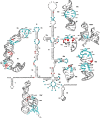Understanding the potential of hepatitis C virus internal ribosome entry site domains to modulate translation initiation via their structure and function
- PMID: 25352252
- PMCID: PMC4361049
- DOI: 10.1002/wrna.1268
Understanding the potential of hepatitis C virus internal ribosome entry site domains to modulate translation initiation via their structure and function
Abstract
Translation initiation in the hepatitis C virus (HCV) occurs through a cap-independent mechanism that involves an internal ribosome entry site (IRES) capable of interacting with and utilizing the eukaryotic translational machinery. In this review, we focus on the structural configuration of the different HCV IRES domains and the impact of IRES primary sequence variations on secondary structure conservation and function. In some cases, multiple mutations, even those scattered across different domains, led to restoration of the translational activity of the HCV IRES, although the individual occurrences of these mutations were found to be deleterious. We propose that such observation may be attributed to probable long-range inter- and/or intra-domain functional interactions. The precise functioning of the HCV IRES requires the specific interaction of its domains with ribosomal subunits and a subset of eukaryotic translation initiation factors (eIFs). The structural conformation, sequence preservation and variability, and translational machinery association with the HCV IRES regions are also thoroughly discussed, along with other factors that can affect and influence the formation of translation initiation complexes.
© 2014 The Authors. WIREs RNA published by John Wiley & Sons, Ltd.
Figures


References
-
- Gravitz L. A smouldering public-health crisis. Nature. 2011;474:S2–S4. - PubMed
-
- Feld JJ, Hoofnagle JH. Mechanism of action of interferon and ribavirin in treatment of hepatitis C. Nature. 2005;436:967–972. - PubMed
-
- Dienstag JL, McHutchison JG. American Gastroenterological Association technical review on the management of hepatitis C. Gastroenterology. 2006;130:231–264. - PubMed
-
- Sofia MJ, Bao D, Chang W, Du JF, Nagarathnam D, Rachakonda S, Reddy PG, Ross BS, Wang PY, Zhang HR. Discovery of a β-d-2′-deoxy-2′-α-fluoro-2′-β-C-methyluridine nucleotide prodrug (PSI-7977) for the treatment of hepatitis C virus. J Med Chem. 2010;53:7202–7218. et al. - PubMed
-
- Lawitz E, Mangia A, Wyles D, Rodriguez-Torres M, Hassanein T, Gordon SC, Schultz M, Davis MN, Kayali Z, Reddy KR. Sofosbuvir for previously untreated chronic hepatitis C infection. New Engl J Med. 2013;368:1878–1887. et al. - PubMed
Publication types
MeSH terms
Substances
LinkOut - more resources
Full Text Sources
Other Literature Sources
Miscellaneous

